YAMAHA TZR50 2012 Owner's Guide
Manufacturer: YAMAHA, Model Year: 2012, Model line: TZR50, Model: YAMAHA TZR50 2012Pages: 92, PDF Size: 5.1 MB
Page 31 of 92
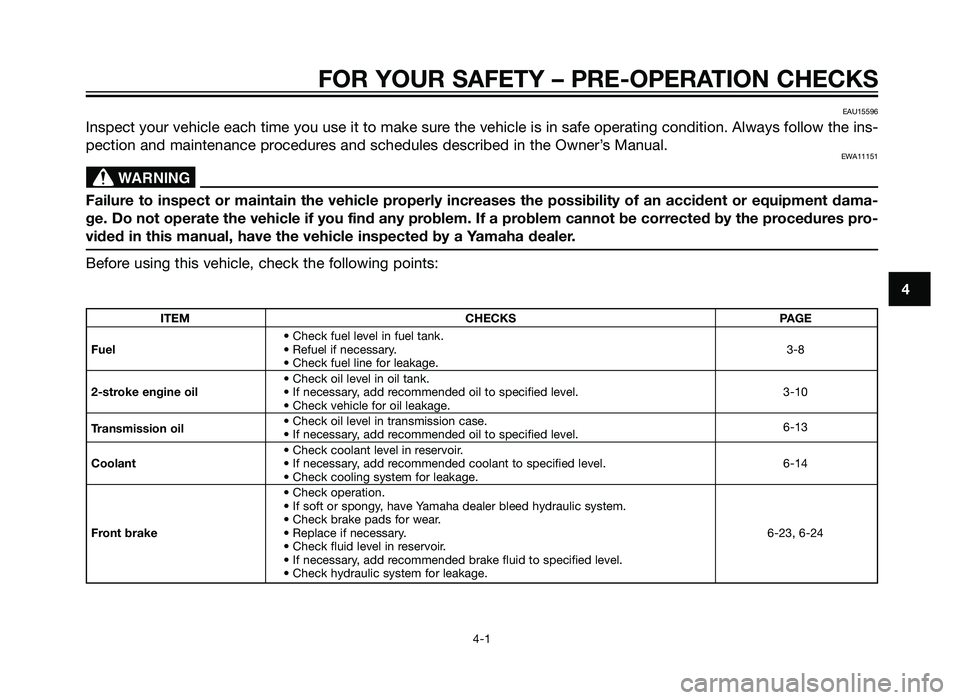
FOR YOUR SAFETY – PRE-OPERATION CHECKS
4-1
4
EAU15596
Inspect your vehicle each time you use it to make sure the vehicle is in safe operating condition. Always follow the ins-
pection and maintenance procedures and schedules described in the Owner’s Manual.
EWA11151
Failure to inspect or maintain the vehicle properly increases the possibility of an accident or equipment dama-
ge. Do not operate the vehicle if you find any problem. If a problem cannot be corrected by the procedures pro-
vided in this manual, have the vehicle inspected by a Yamaha dealer.
Before using this vehicle, check the following points:
WARNING
ITEMCHECKS PAGE
• Check fuel level in fuel tank.
Fuel • Refuel if necessary. 3-8
• Check fuel line for leakage.
• Check oil level in oil tank.
2-stroke engine oil • If necessary, add recommended oil to specified level. 3-10
• Check vehicle for oil leakage.
Transmission oil • Check oil level in transmission case.
• If necessary, add recommended oil to specified level. 6-13
• Check coolant level in reservoir.
Coolant • If necessary, add recommended coolant to specified level. 6-14
• Check cooling system for leakage.
• Check operation.
• If soft or spongy, have Yamaha dealer bleed hydraulic system.
• Check brake pads for wear.
Front brake • Replace if necessary. 6-23, 6-24
• Check fluid level in reservoir.
• If necessary, add recommended brake fluid to specified level.
• Check hydraulic system for leakage.
1HD-F819D-E0 7/3/11 20:27 Página 31
2AS-F819D-E0.indd 3131/07/12 10:09
Page 32 of 92
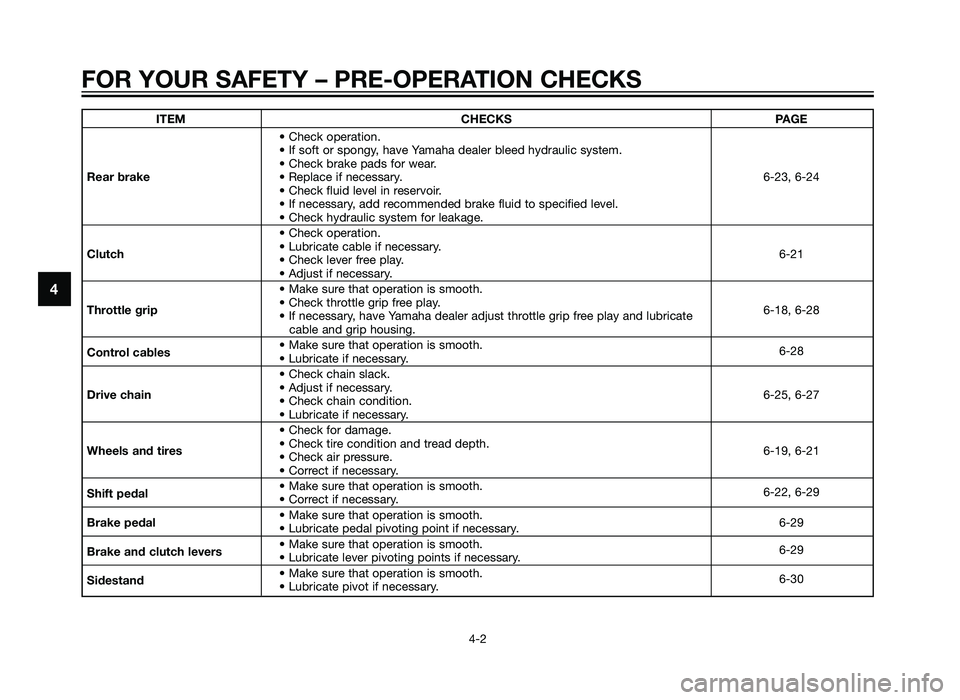
FOR YOUR SAFETY – PRE-OPERATION CHECKS
4-2
4
ITEMCHECKS PAGE
• Check operation.
• If soft or spongy, have Yamaha dealer bleed hydraulic system.
• Check brake pads for wear.
Rear brake • Replace if necessary. 6-23, 6-24
• Check fluid level in reservoir.
• If necessary, add recommended brake fluid to specified level.
• Check hydraulic system for leakage.
• Check operation.
Clutch • Lubricate cable if necessary.
6-21
• Check lever free play.
• Adjust if necessary.
• Make sure that operation is smooth.
Throttle grip • Check throttle grip free play.
6-18, 6-28
• If necessary, have Yamaha dealer adjust throttle grip free play and lubricate
cable and grip housing.
Control cables • Make sure that operation is smooth.
• Lubricate if necessary. 6-28
• Check chain slack.
Drive chain • Adjust if necessary.
6-25, 6-27
• Check chain condition.
• Lubricate if necessary.
• Check for damage.
Wheels and tires • Check tire condition and tread depth.
6-19, 6-21
• Check air pressure.
• Correct if necessary.
Shift pedal • Make sure that operation is smooth.
• Correct if necessary. 6-22, 6-29
Brake pedal • Make sure that operation is smooth.
6-29
• Lubricate pedal pivoting point if necessary.
Brake and clutch levers • Make sure that operation is smooth.
• Lubricate lever pivoting points if necessary. 6-29
Sidestand • Make sure that operation is smooth.
• Lubricate pivot if necessary. 6-30
1HD-F819D-E0 7/3/11 20:27 Página 32
2AS-F819D-E0.indd 3231/07/12 10:09
Page 33 of 92

ITEMCHECKS PAGE
Chassis fasteners • Make sure that all nuts, bolts and screws are properly tightened.
• Tighten if necessary. —
Instruments, lights, signals • Check operation.
and switches• Correct if necessary. —
Engine stop switch
• Check operation. 3-4
Sidestand switch • Check operation of ignition circuit cut-off system.
• If system is not working correctly, have Yamaha dealer check vehicle. 3-14
FOR YOUR SAFETY – PRE-OPERATION CHECKS
4-3
4
1HD-F819D-E0 7/3/11 20:27 Página 33
2AS-F819D-E0.indd 3331/07/12 10:09
Page 34 of 92

EAU15951
Read the Owner’s Manual carefully to
become familiar with all controls. If
there is a control or function you do
not understand, ask your Yamaha
dealer.
EWA10271
Failure to familiarize yourself with
the controls can lead to loss of
control, which could cause an acci-
dent or injury.
EAU16055
Starting a cold engine
In order for the ignition circuit cut-off
system to enable starting, one of the
following conditions must be met:
�The transmission is in the neutral
position.
�The transmission is in gear with
the clutch lever pulled and the
sidestand up.
See page 3-14 for more information. 1. Turn the fuel cock lever to “ON”.
2. Turn the key to “ ” and make sure that the engine stop switch
is set to “ ”.
3. Shift the transmission into the neutral position. The neutral indi-
cator light should come on. If not,
ask a Yamaha dealer to check the
electrical circuit.
4. Turn the starter (choke) on and completely close the throttle.
(See page 3-12).
5. Start the engine by pushing the start switch.
If the engine fails to start, release
the start switch, wait a few
seconds, and then try again.
Each starting attempt should be as short as possible to preserve
the battery. Do not crank the
engine more than 10 seconds on
any one attempt.
6. After starting the engine, move the starter (choke) back halfway.
7. When the engine is warm, turn the starter (choke) off.
TIP
The engine is warm when it responds
quickly to the throttle with the starter
(choke) turned off.
ECA11042
For maximum engine life, never
accelerate hard when the engine is
cold!
NOTICE
WARNING
OPERATION AND IMPORTANT RIDING POINTS
5-1
5
1HD-F819D-E0 7/3/11 20:27 Página 34
2AS-F819D-E0.indd 3431/07/12 10:09
Page 35 of 92
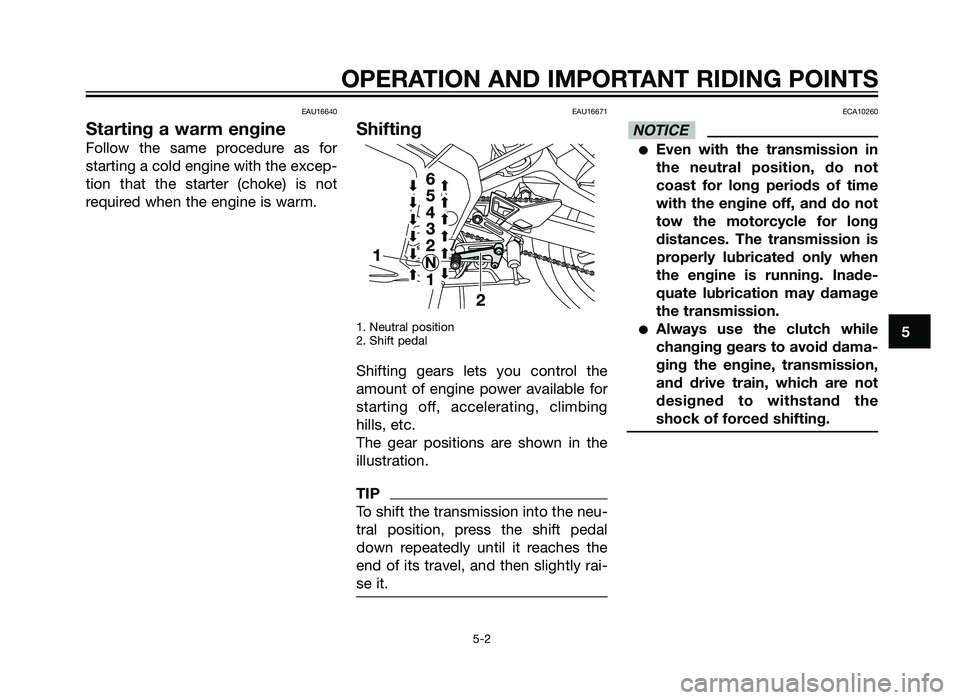
EAU16640
Starting a warm engine
Follow the same procedure as for
starting a cold engine with the excep-
tion that the starter (choke) is not
required when the engine is warm.
EAU16671
Shifting
1. Neutral position
2. Shift pedal
Shifting gears lets you control the
amount of engine power available for
starting off, accelerating, climbing
hills, etc.
The gear positions are shown in the
illustration.
TIP
To shift the transmission into the neu-
tral position, press the shift pedal
down repeatedly until it reaches the
end of its travel, and then slightly rai-
se it.
ECA10260
�Even with the transmission in
the neutral position, do not
coast for long periods of time
with the engine off, and do not
tow the motorcycle for long
distances. The transmission is
properly lubricated only when
the engine is running. Inade-
quate lubrication may damage
the transmission.
�Always use the clutch while
changing gears to avoid dama-
ging the engine, transmission,
and drive train, which are not
designed to withstand the
shock of forced shifting.
NOTICE
OPERATION AND IMPORTANT RIDING POINTS
5-2
5
1HD-F819D-E0 7/3/11 20:27 Página 35
2AS-F819D-E0.indd 3531/07/12 10:09
Page 36 of 92
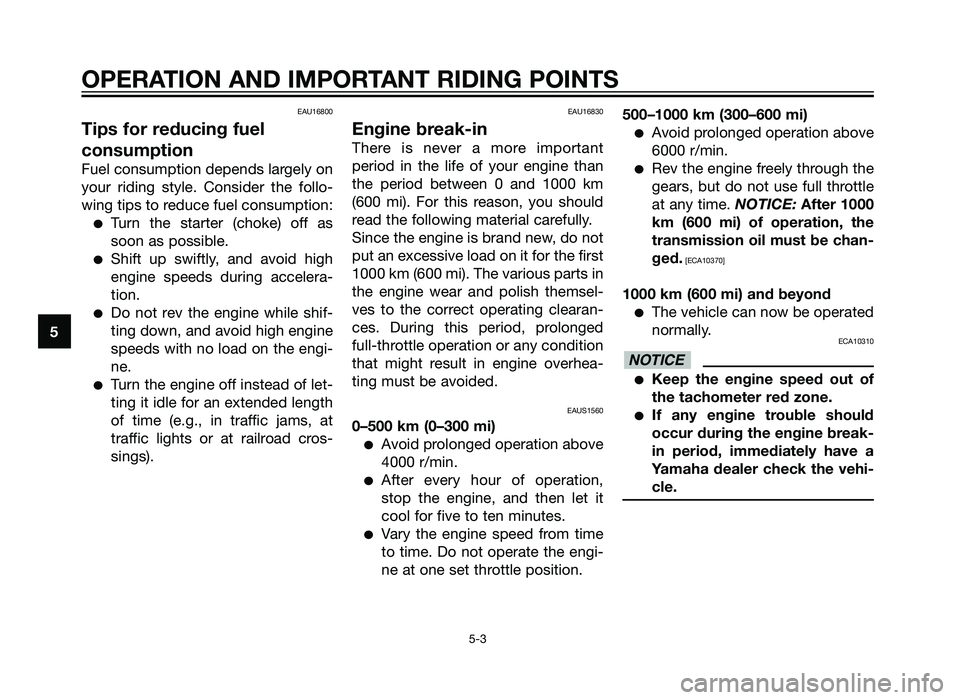
EAU16800
Tips for reducing fuel
consumption
Fuel consumption depends largely on
your riding style. Consider the follo-
wing tips to reduce fuel consumption:
�Turn the starter (choke) off as
soon as possible.
�Shift up swiftly, and avoid high
engine speeds during accelera-
tion.
�Do not rev the engine while shif-
ting down, and avoid high engine
speeds with no load on the engi-
ne.
�Turn the engine off instead of let-
ting it idle for an extended length
of time (e.g., in traffic jams, at
traffic lights or at railroad cros-
sings).
EAU16830
Engine break-in
There is never a more important
period in the life of your engine than
the period between 0 and 1000 km
(600 mi). For this reason, you should
read the following material carefully.
Since the engine is brand new, do not
put an excessive load on it for the first
1000 km (600 mi). The various parts in
the engine wear and polish themsel-
ves to the correct operating clearan-
ces. During this period, prolonged
full-throttle operation or any condition
that might result in engine overhea-
ting must be avoided.
EAUS1560
0–500 km (0–300 mi)
�Avoid prolonged operation above
4000 r/min.
�After every hour of operation,
stop the engine, and then let it
cool for five to ten minutes.
�Vary the engine speed from time
to time. Do not operate the engi-
ne at one set throttle position.500–1000 km (300–600 mi)
�Avoid prolonged operation above
6000 r/min.
�Rev the engine freely through the
gears, but do not use full throttle
at any time.
NOTICE:After 1000
km (600 mi) of operation, the
transmission oil must be chan-
ged.
[ECA10370]
1000 km (600 mi) and beyond
�The vehicle can now be operated
normally.
ECA10310
�Keep the engine speed out of
the tachometer red zone.
�If any engine trouble should
occur during the engine break-
in period, immediately have a
Yamaha dealer check the vehi-
cle.
NOTICE
OPERATION AND IMPORTANT RIDING POINTS
5-3
5
1HD-F819D-E0 7/3/11 20:27 Página 36
2AS-F819D-E0.indd 3631/07/12 10:09
Page 37 of 92
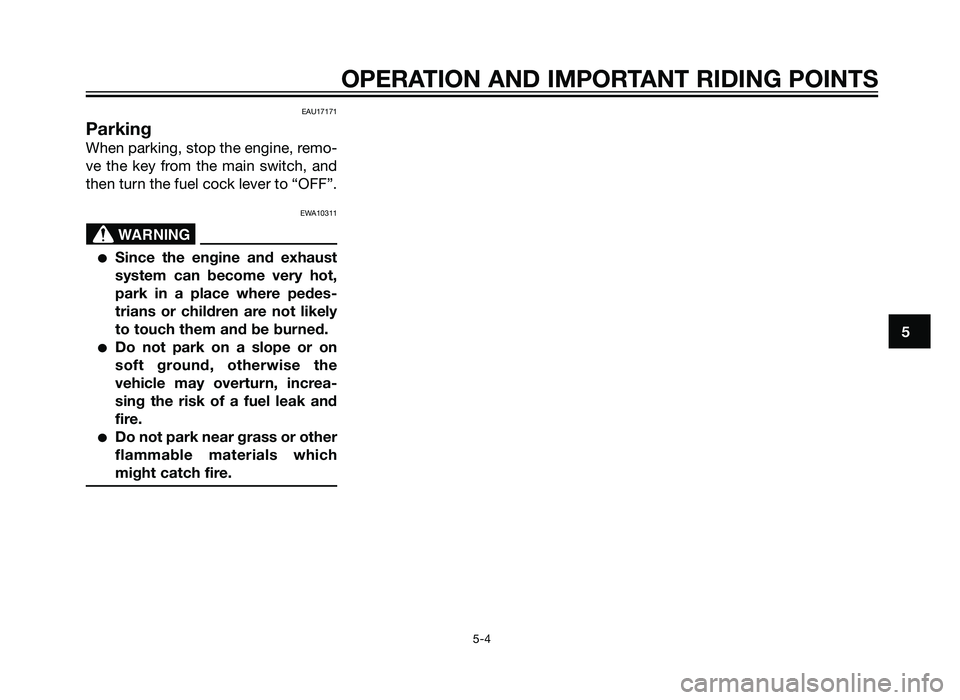
EAU17171
Parking
When parking, stop the engine, remo-
ve the key from the main switch, and
then turn the fuel cock lever to “OFF”.
EWA10311
�Since the engine and exhaust
system can become very hot,
park in a place where pedes-
trians or children are not likely
to touch them and be burned.
�Do not park on a slope or on
soft ground, otherwise the
vehicle may overturn, increa-
sing the risk of a fuel leak and
fire.
�Do not park near grass or other
flammable materials which
might catch fire.
WARNING
OPERATION AND IMPORTANT RIDING POINTS
5-4
5
1HD-F819D-E0 7/3/11 20:27 Página 37
2AS-F819D-E0.indd 3731/07/12 10:09
Page 38 of 92
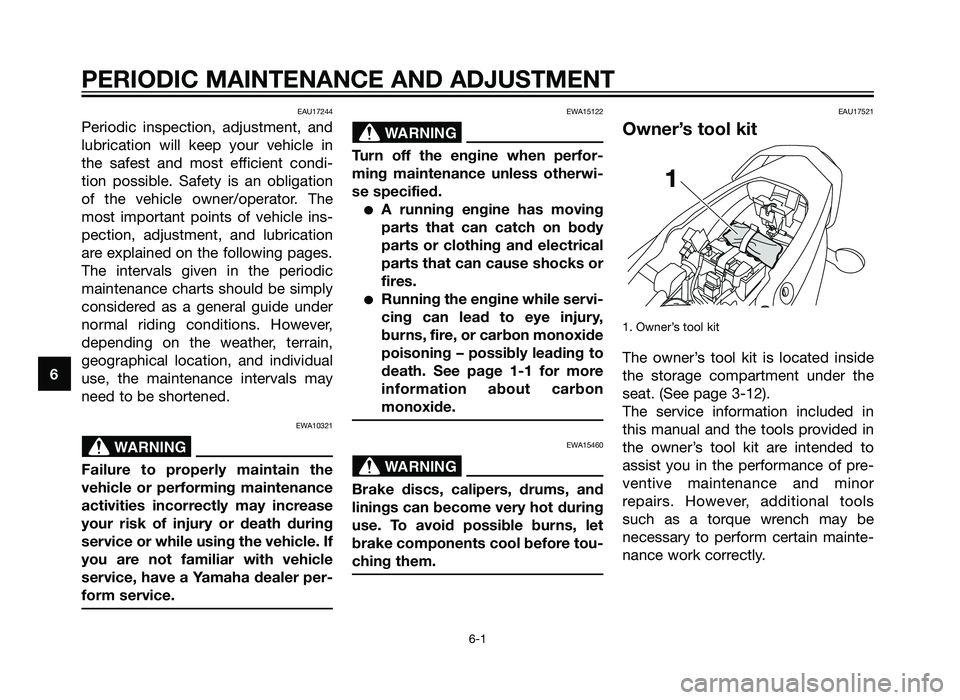
EAU17244
Periodic inspection, adjustment, and
lubrication will keep your vehicle in
the safest and most efficient condi-
tion possible. Safety is an obligation
of the vehicle owner/operator. The
most important points of vehicle ins-
pection, adjustment, and lubrication
are explained on the following pages.
The intervals given in the periodic
maintenance charts should be simply
considered as a general guide under
normal riding conditions. However,
depending on the weather, terrain,
geographical location, and individual
use, the maintenance intervals may
need to be shortened.
EWA10321
Failure to properly maintain the
vehicle or performing maintenance
activities incorrectly may increase
your risk of injury or death during
service or while using the vehicle. If
you are not familiar with vehicle
service, have a Yamaha dealer per-
form service.
EWA15122
Turn off the engine when perfor-
ming maintenance unless otherwi-
se specified.
�A running engine has moving
parts that can catch on body
parts or clothing and electrical
parts that can cause shocks or
fires.
�Running the engine while servi-
cing can lead to eye injury,
burns, fire, or carbon monoxide
poisoning – possibly leading to
death. See page 1-1 for more
information about carbon
monoxide.
EWA15460
Brake discs, calipers, drums, and
linings can become very hot during
use. To avoid possible burns, let
brake components cool before tou-
ching them.
EAU17521
Owner’s tool kit
1. Owner’s tool kit
The owner’s tool kit is located inside
the storage compartment under the
seat. (See page 3-12).
The service information included in
this manual and the tools provided in
the owner’s tool kit are intended to
assist you in the performance of pre-
ventive maintenance and minor
repairs. However, additional tools
such as a torque wrench may be
necessary to perform certain mainte-
nance work correctly.
WARNING
WARNING
WARNING
PERIODIC MAINTENANCE AND ADJUSTMENT
6-1
6
1HD-F819D-E0 7/3/11 20:27 Página 38
2AS-F819D-E0.indd 3831/07/12 10:09
Page 39 of 92
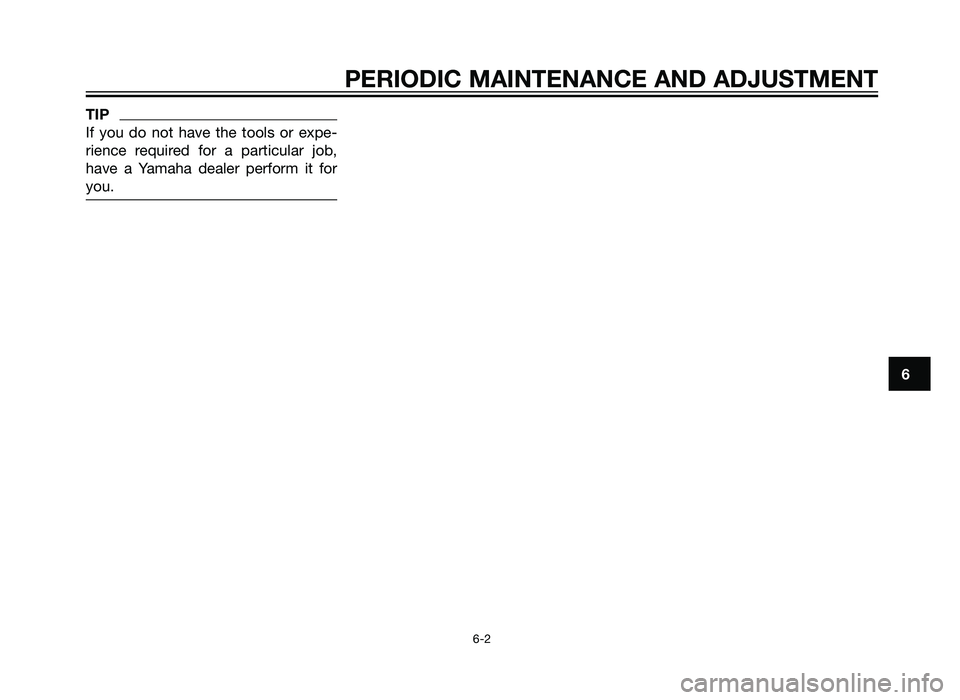
PERIODIC MAINTENANCE AND ADJUSTMENT
6-2
6
TIP
If you do not have the tools or expe-
rience required for a particular job,
have a Yamaha dealer perform it for
you.
1HD-F819D-E0 7/3/11 20:27 Página 39
2AS-F819D-E0.indd 3931/07/12 10:09
Page 40 of 92
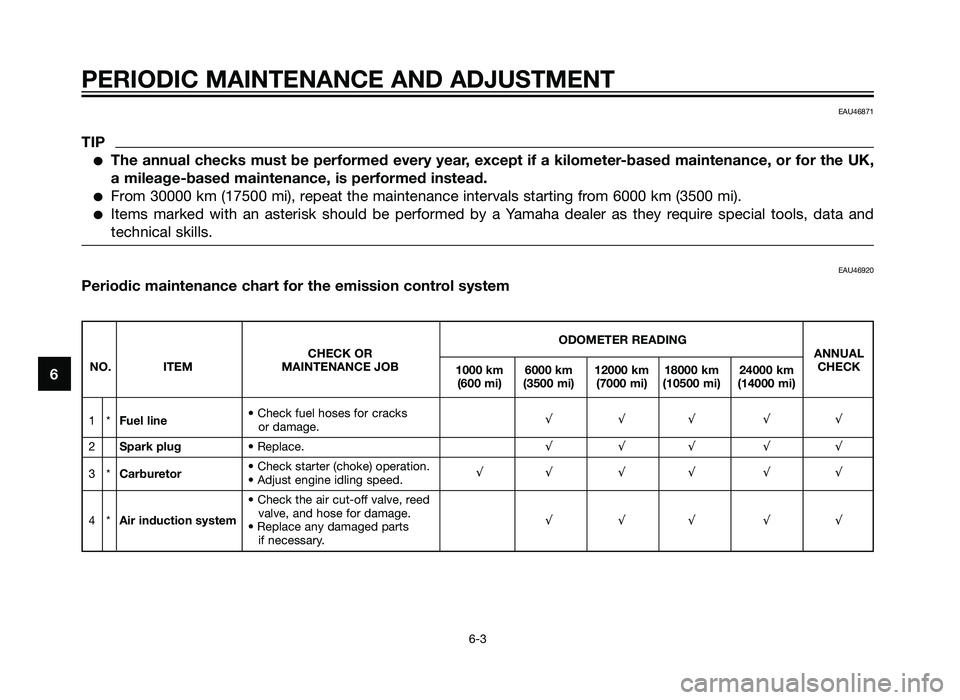
EAU46871
TIP
�The annual checks must be performed every year, except if a kilometer-based maintenance, or for the UK,
a mileage-based maintenance, is performed instead.
�From 30000 km (17500 mi), repeat the maintenance intervals starting from 6000 km (3500 mi).
�Items marked with an asterisk should be performed by a Yamaha dealer as they require special tools, data and
technical skills.
EAU46920
Periodic maintenance chart for the emission control system
PERIODIC MAINTENANCE AND ADJUSTMENT
6-3
6
ODOMETER READING
CHECK OR ANNUAL
NO. ITEM MAINTENANCE JOB
1000 km 6000 km 12000 km 18000 km 24000 km CHECK
(600 mi) (3500 mi) (7000 mi) (10500 mi) (14000 mi)
1* Fuel line • Check fuel hoses for cracks
or damage. √ √√ √ √
2
Spark plug • Replace. √ √√ √ √
3* Carburetor • Check starter (choke) operation.
• Adjust engine idling speed. √√ √ √ √ √
• Check the air cut-off valve, reed
4* Air induction system valve, and hose for damage.
√ √√ √ √
• Replace any damaged parts
if necessary.
1HD-F819D-E0 7/3/11 20:27 Página 40
2AS-F819D-E0.indd 4031/07/12 10:09